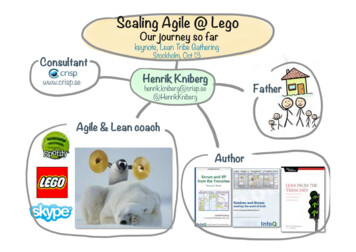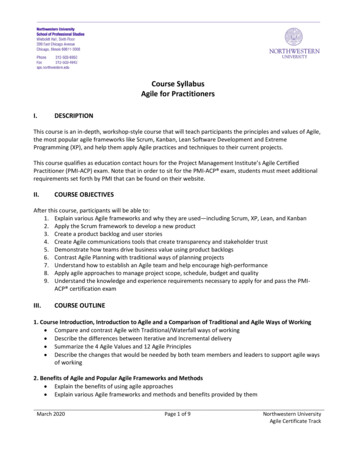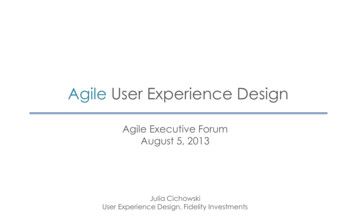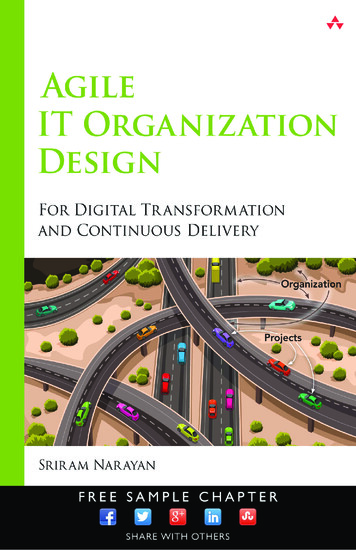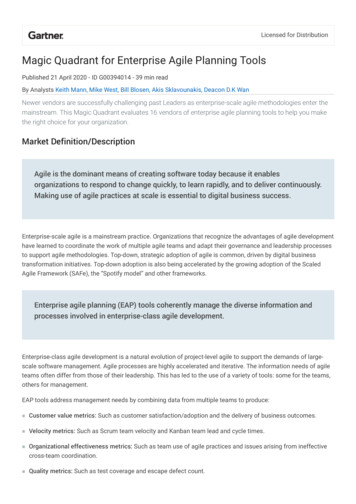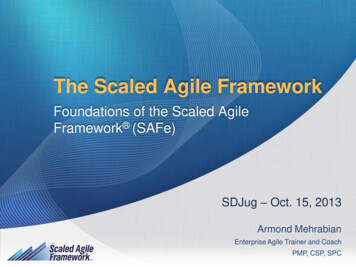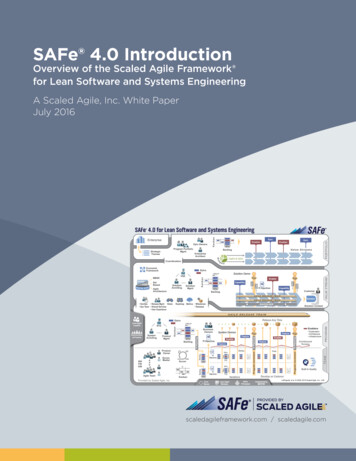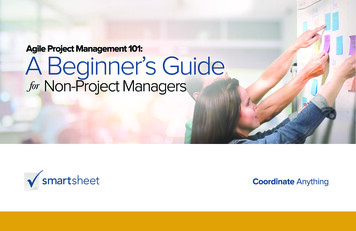
Transcription
01 Introduction02 Agile overview03 12 Agile Principles05 Agile Development Cycle06 Advantages & Disadvantages of Agile08 Top Methodologies Used to Implement Agile09 Top Methodologies Used to Implement Agile - Scrum15 Top Methodologies Used to Implement Agile - Kanban20 Other Agile Methodologies21 How to Get Started With Agile23 Finding the Best Agile Tool25 About Smartsheet
IntroductionEveryone manages projects, whether they’re a certified project manager or not.Often the people managing the work are simply ‘winging it’, which can result ina struggle to manage multiple projects, meet deadlines, and adapt to changingrequirements.Studies have found that companies who use a standard project managementmethodology have had “fewer than half as many project failures than those thatdid not have one.” With this in mind, anyone who manages work should consideradopting a standard project management method. But with all the PM methodsout there, how are you to know which one is best for your work managementneeds?In this e-book, we’ll take a look at the Agile project management philosophy.We’ll give an overview of the top Agile methods, provide the advantages anddisadvantages of each, and tell you how you can get started implementing Agilepractices to ensure your next project is a success.pg1
The Project Killer:Poor CommunicationAgile OverviewAgile project management is based on an incremental, iterative approach.Instead of in-depth planning at the beginning of the project, Agile methodologiesare open to changing requirements over time and encourages constantfeedback from the end users. The goal of each iteration is to produce a workingproduct.Agile refers to any process that aligns with the concepts of the Agile Manifesto.In 2001, 17 software developers met to discuss lightweight developmentmethods. They published the Manifesto for Agile Software Development, whichcovered how they found “better ways of developing software by doing it andhelping others do it.”A 2013 PMI study found that poor communicationwas the primary contributor to project failure onethird of the time and had a negative impact onproject success more than half the time.pg2
12 Agile PrinciplesThe Agile Manifesto lists 12 principles to guide teams on how to execute withagility:1. Our highest priority is to satisfy the customer through early and continuousdelivery of valuable software.2. Welcome changing requirements, even late in development. Agileprocesses harness change for the customer’s competitive advantage.3. Deliver working software frequently, from a couple of weeks to a couple ofmonths, with preference to the shorter timescale.4. Business people and developers must work together daily throughout theproject.5. Build projects around motivated individuals. Give them the environmentand support they need, and trust them to get the job done.6. The most efficient and effective method of conveying information to andwithin a development team is face-to-face conversation.pg3
12 Agile Principles7. Working software is the primary measure of progress.8. Agile processes promote sustainable development. The sponsors,developers, and users should be able to maintain a constant paceindefinitely.9. Continuous attention to technical excellence and good designenhances agility.10. Simplicity -- the art of maximizing the amount of work not done -- isessential11. The best architectures, requirements, and designs emerge from selforganizing teams.12. At regular intervals, the team reflects on how to become moreeffective, then tunes and adjusts its behavior accordingly.pg4
Agile Development CycleThe phases in the Agile development cycle may not happen in succession; theyare flexible and always evolving, with many happening in parallel.Planning: Once an idea is deemed viable, the project team comes together toidentify features, prioritize each feature, and assign them to an iteration.Requirements analysis: Key stakeholders and users meet to identify businessrequirements that are quantifiable, relevant, and detailed.Design: The design is prepared from the requirements identified and theteam considers what the product or solution will look like, deciding on a teststrategy or plan to proceed.Implementation, coding or development: Coding or developing features, andscheduling iterations for deployment.Testing: Test the code against the requirements to make sure the product isactually solving customer needs. This phase includes unit testing, integrationtesting, system testing, and acceptance testing.Deployment: Deliver the product to customers. Once customers start usingthe product, they may run into new problems that the project team will need toaddress in future iterations.pg5
Advantages of AgileAgile evolved from different development approaches in the 1990s and isa response to some project managers’ dislike of the rigid, linear Waterfallmethodology. It focuses on flexibility, continuous improvement, and speed.Here are some of the top advantages of Agile:Change is embraced: With shorter planning cycles, there’s always opportunityto refine and reprioritize the backlog to accommodate changes throughout theproject.End-goal can be unknown: Agile is beneficial for projects where the end-goalis not clearly defined. As the project progresses, the goals will become evidentand the team can adapt.Faster, high-quality delivery: Breaking down the project into iterations allowsthe team to focus on high-quality development, testing, and collaboration.Conducting testing during each iteration means that bugs get identified andsolved more quickly.Strong team interaction: Agile embraces frequent communication and face-toface interactions.Customers are heard: Customers have many opportunities to see the workbeing delivered, share their input, and have an impact on the end product.Continuous improvement: Feedback is encouraged from users and teammembers throughout the project, so lessons learned are used to improvefuture iterations.pg6
Disadvantages of AgileWhile flexibility in Agile is usually a positive, it also comes with some trade-offs. Itcan be hard to establish a solid delivery date, documentation can be neglected,or the final product can be very different than originally intended.Here are some of the disadvantages of Agile:Planning can be less concrete: Because project managers are oftenreprioritizing tasks, it’s possible some items scheduled for delivery may notbe complete in time. And, additional sprints may be added at any time in theproject, adding to the overall timeline.Team must be knowledgeable: Agile teams are usually small, so teammembers must be highly skilled in a variety of areas and understand Agilemethodology.Time commitment from developers: Active involvement and collaboration isrequired throughout the Agile process, which is more time consuming than atraditional approach.Documentation can be neglected: Agile prefers working deliverables overcomprehensive documentation. While documentation on its own does not leadto success, teams should find the right balance between documentation anddiscussion.pg7
Top Methodologies Used toImplement AgileThere are a number of specific methodswithin the Agile movement. We’ll takean in-depth look at two of the top AgileMethodologies: Scrum and Kanban.pg8
1Scrum MethodologyScrum is a subset of Agile and one of the most popular process frameworks forimplementing Agile. It is an iterative development model often used to managecomplex software and product development. Fixed-length iterations, calledsprints lasting one to two weeks long, allow the team to ship software on aregular cadence. At the end of each sprint, stakeholders and team membersmeet to plan next steps.pg9
Advantages of ScrumScrum is a highly prescriptive framework with specific roles and ceremonies.While it can be a lot to learn, these rules have a lot of advantages:More transparency and project visibility: With daily stand-up meetings, thewhole team knows who is doing what and issues are identified in advance,improving communication and enabling the team to take care of issues rightaway.Increased team accountability: There is no project manager. Instead, the teamcollectively decides what work they can complete in each sprint, workingtogether collaboratively, with accountability.Easy to accommodate changes: With short sprints and constant feedback, it’seasier to accommodate changes.Increased cost savings: Constant communication ensures the team is awareof all issues and changes sooner, helping to lower expenses and increasequality.pg10
Disadvantages of ScrumWhile Scrum offers some concrete benefits, it also has some downsides. Scrumrequires a high level of experience and commitment from the team and projectscan be at risk of scope creep:Risk of scope creep: Some Scrum projects can experience scope creep dueto a lack of a specific end date, tempting stakeholders to keep requestingadditional functionality.Team requires experience and commitment: The team needs to be familiarwith Scrum principles to succeed, as well as needs to commit to the dailymeetings and stay on the team for the entire project.The wrong Scrum Master can ruin everything: The Scrum Master is verydifferent from a project manager. The Scrum Master does not have authorityover the team, so he or she must trust the team to complete the work.Poorly defined tasks can lead to inaccuracies: Project costs and timelineswon’t be accurate if tasks are not well defined. If the initial goals are unclear,planning becomes difficult and sprints can take more time than originallyestimated.pg11
Roles in ScrumThere are three specific roles in Scrum:Product Owner: The Scrum Product Owner has the vision of what to buildand conveys that to the team. He or she focuses on business and marketrequirements, prioritizing the work that needs to be done, managing thebacklog, providing guidance on which features to ship next, and interactingwith the team and other stakeholders to make sure everyone understands theitems on the product backlog.Scrum Master: Often considered the coach for the team, the Scrum Masterhelps the team do their best possible work. This means organizing meetings,dealing with roadblocks and challenges, and working with the Product Ownerto ensure the product backlog is ready for the next sprint.Scrum Team: The Scrum Team is comprised of five to seven members. Unliketraditional development teams, there are not distinct roles like programmer,designer, or tester. Everyone on the project completes the set of worktogether.pg12
Steps in the Scrum ProcessThere are a specific, unchanging set of steps in the Scrum flow:1. Product backlog: The product backlog is not a list of things to becompleted, but rather it is a list of all the desired features for the product.Sprint planning: Before each sprint, the Product Owner presents the topitems on the backlog in a sprint planning meeting. The team determinesthe work they can complete during the sprint and moves the work from theproduct backlog to the sprint backlog.2. Backlog refinement/grooming: At the end of each sprint, the team andProduct Owner meet to make sure the backlog is ready for the next sprint.The team may remove user stories that aren’t relevant, create new userstories, reassess the priority of stories, or split user stories into smallertasks.3. Daily Scrum meetings: The Daily Scrum is a 15-minute stand-up meetingthat happens at the same time and place every day during the sprint.During the meeting each team member talks about what they worked onthe day before, what they’ll work on today, and any roadblocks.4. Sprint review meeting: At the end of each sprint, the team presents thework they have completed as a live demo rather than a presentation.Sprint retrospective meeting: Also at the end of each sprint, the teamreflects on how well Scrum is working for them and talks about anychanges that need to be made in the next sprint.pg13
Tools and Artifacts in ScrumIn addition to roles and ceremonies, Scrum projects also include certain toolsand “artifacts”. For example, the team uses a Scrum board to visualize thebacklog or a burndown chart to show outstanding work. The most commonartifacts and tools are:Scrum board: The Scrum board helps to visualize your sprint backlog andtraditionally involves index cards or Post-It notes on a whiteboard. The boardis usually divided into three categories: to do, work in progress, and done.The team updates the board by moving tasks (written on cards) through thecolumns on the board.User stories: A user story describes a software feature from the customer’sperspective. It includes the type of user, what they want, and why they want it.Burndown chart: A burndown chart represents all outstanding work. Thebacklog is usually on the vertical axis, with time along the horizontal axis. Aburndown chart can warn the team of potential risk and helps to show theimpact of decisions.Timeboxing: A timebox is a set period of time that a team works towardscompleting a goal. Instead of letting a team work until the goal is reached, thetimebox approach stops work when the time limit is reached.Icebox: Any user stories that are recorded but not moved to development arestored in the icebox.pg14
2 Kanban MethodologyKanban is Japanese for “visual sign” or “card.” It is a visual framework used toimplement Agile and shows what to produce, when to produce it, and how muchto produce. It encourages small, incremental changes to your current systemand does not require a certain set up or procedure (meaning, you could overlayKanban on top of other existing workflows).Kanban was inspired by the Toyota Production System and Lean Manufacturing.In the 1940s, Toyota improved its engineering process by modeling it after howsupermarkets stock shelves. Engineer Taiichi Ohno noticed that supermarketsstock just enough product to meet demand. Inventory would only be restockedwhen there was empty space on the shelf (a visual cue).These same ideas apply to software teams and IT projects today. In this context,development work-in-progress (WIP) takes the place of inventory, and new workcan only be added when there is an “empty space” on the team’s visual Kanbanboard. Kanban matches the amount of WIP to the team’s capacity, improvingflexibility, transparency, and output.pg15
About the Kanban BoardA Kanban board is a tool to implement the Kanban method for projects.Traditionally, this tool has been a physical board, with magnets, plastic chips, orsticky notes on a whiteboard. However, in recent years, more and more projectmanagement software tools have created online Kanban boards.A Kanban board, whether it is physical or online, is made up of different swimlanes or columns. The simplest boards have three columns: to do, in progress,and done. Other projects may consist of backlog, ready, coding, testing,approval, and done columns.Kanban cards (like sticky notes) represent the work and each card is placedon the board in the lane that represents the status of that work. These cardscommunicate status at a glance. You could also use different color cards torepresent different details. For example, green cards could represent a featureand orange cards could represent a task.pg16
Advantages of KanbanKanban’s visual nature offers a unique advantage when implementing Agile. TheKanban board is easy to learn and understand, it improves flow of work, andminimizes cycle time:Increases flexibility: Kanban is an evolving, fluid model. There are no setphase durations and priorities are reevaluated with new information.Reduces waste: Kanban revolves around reducing waste, ensuring that teamsdon’t spend time doing work that isn’t needed or doing the wrong kind ofwork.Easy to understand: The visual nature of Kanban helps to make it intuitive andeasy to learn.Improves delivery flow: Kanban focuses on the just-in-time delivery of valueand delivering work to customers on a regular cadence.Minimizes cycle time: Cycle time is the amount of time it takes for work tomove through the team’s workflow. In Kanban projects, the entire team helpsto ensure the work is moving quickly and successfully through the process.pg17
Disadvantages of KanbanMany of the disadvantages associated with Kanban come with misuse ormishandling of the Kanban board. An outdated or overcomplicated board canlead to confusion, inaccuracies, or miscommunication:Outdated board can lead to issues: The team must be committed to keepingthe Kanban board up to date, otherwise they’ll be working off inaccurateinformation.Teams can overcomplicate the board: The Kanban board should remain clearand easy to read. Adding bells and whistles to the Kanban board just buriesthe important information.Lack of timing: The columns on the Kanban board are marked by phase, withno timeframes associated.pg18
Core Practices and Principles of KanbanEvery Kanban project should follow these core principles:Visualize the workflow: A visual representation of your work allows you tounderstand the big picture and see how the flow of work progresses. Bymaking all the work visible you can identify issues early on and improvecollaboration.Limit work in progress (WIP): Work in progress limits determine the minimumand maximum amount of work for each column on the board or for eachworkflow. By putting a limit on WIP, you can increase speed and flexibility, andreduce the need for prioritizing tasks.Manage and enhance the flow: The flow of work throughout the Kanbanboard should be monitored for possible improvements. A fast, smooth flowshows the team is creating value quickly.Make process policies explicit: Everyone needs to understand how thingswork or what qualifies as “done”. Modify the board to make these processesmore clear.Continuously improve: The Kanban method encourages small, continuouschanges that stick. Once the Kanban system is in place, the team will be ableto identify and understand issues and suggest improvements.pg19
Other Agile MethodologiesExtreme Programming (XP): This type of software development is intended toimprove quality and responsiveness to evolving customer requirements.Feature-driven development (FDD): There are five basic activities in FDD:develop overall model, build feature list, plan by feature, design by feature, andbuild by feature.Adaptive system development (ASD): ASD represents the idea that projectsshould always be in a state of continuous adaptation, and has a cycle of threerepeating series: speculate, collaborate, and learn.Dynamic Systems Development Method (DSDM): DSDM addresses the commonfailures of IT projects, like going over budget, missing deadlines, and lack ofuser involvement. The eight principles of DSDM are: focus on the business need,deliver on time, collaborate, never compromise quality, build incrementally fromfirm foundations, develop iteratively, communicate continuously and clearly, anddemonstrate control.Lean Software Development (LSD): LSD can be characterized by sevenprinciples: eliminate waste, amplify learning, decide as late as possible, deliveras fast as possible, empower the team, build integrity in, and see the whole.Crystal Clear: This methodology can be used with teams of six to eightdevelopers and it focuses on the people, not processes or artifacts. CrystalClear requires the following: frequent delivery of usable code to users, reflectiveimprovement, and osmotic communication preferably by being co-located.pg20
How to Get Started with AgileGetting started with Agile can be easy. We’lltake a look at a few ways to implementAgile practices and how to pick the rightAgile tool.pg21
3 Ways to Implement Agile PracticesWhichever route you choose, remember that Agile is flexible in its very nature.There is no wrong or right way to get started with Agile.Stand up Meetings: A simple way to get started with Agile is to incorporatedaily stand-up meetings into your project. Daily stand-up meetings are easy toincorporate into any project methodology you already use (even Waterfall) anddon’t require any training or knowledge transfer.Kanban Board: Another way to incorporate Agile practices is to create and usea Kanban board. The Kanban board is simple tool to help your team visualizethe flow of work as it’s getting done. Use the board during stand-up meetings todiscuss current work in progress or display it where your team can easily accessit to make updates to task status.Changing Team Roles: Some methods of Agile may result in the need to changeteam roles. For example, working with Scrum, the team may need to take moreresponsibility and boost speed of delivery. A good place to start with Scrum isto talk about the roles and responsibilities. Every project must have a ScrumMaster, Product Owner, and Scrum Team. Clarifying these roles will help teamsunderstand their responsibilities and remain accountable.pg22
Finding the Best Agile ToolIf you’re considering a switch to Agile project management, you shoulddetermine which tool is best to help track and manage your projects. Here arethe top things to consider when choosing a tool:Familiar and Easy to Use: When switching to a new tool, familiarity is key. Youdon’t want your team spending valuable time learning a new program. Agileproject management software should be flexible and intuitive to use.Collaboration and Communication: Find a tool that facilitates collaborationbetween internal and external stakeholders. Cloud tools enable people towork in real-time, view and edit projects from anywhere, stay up to date oncurrent status, and communicate with others viewing the project.Searchable, Central Storage: It’s increasingly important to use cloudstorage services like Dropbox, Google Drive, Box, or OneDrive for projectdocumentation storage. Whatever service you use, make sure your Agile toolcan seamlessly connect with them to store vital assets.Mobile Ready: The modern worker relies on their smartphone, tablet and othermobile devices to get work done. And many workers want to access partsof their project management software while they are on the go. Be sure toevaluate all the mobile options a tool has to offer.Work Visualization: Today, work design is infinitely different. The “one-sizefits-all” approach to project management no longer works. Find a tool thatincludes multiple ways to visualize and manage your work - whether it bewaterfall or agile - with Gantt charts, spreadsheet, kanban boards, calendars,reports, and dashboards.pg23
Wrap Up: A More Agile Way to Manage WorkWith fewer than one-third of all projects completed on time and on budget, itcan sometimes seem impossible to lead new projects to success.That’s why finding the best project management method is important to thesuccess of your projects. Whether you decide to go with Agile, Scrum, Kanban,or even a hybrid of multiple methods, deciding on a standard way to manageprojects will help to streamline the process, increase team output, and keepprojects on track.Plus, once you’ve picked the best method for your team, finding the right agileproject management tool can help implement and track the process and ensureno detail is missed.pg24
About SmartsheetSmartsheet is changing the way that individuals, teams, and organizations delivergreat work. Our collaborative work management platform is trusted by over over8 million registered users in 80,000 customers across more than 190 countries.Smartsheet is used by organizations across all major industries includingtechnology, construction, financial services, education, and more.By providing a broad range of smart views – Grid, Calendar, Gantt, Sights –Smartsheet works the way you want. Our newest view, Card View, gives teamsa more highly-visual way to work, communicate, and collaborate in Smartsheet.Plus, with a similar feel as excel, Smartsheet is easy to start using right away, yetit’s cloud-based so you can access your data and information anywhere, anytime.Want to know how Smartsheet can help individuals and teams implement Agilepractices? Click here to see firsthand how our new Card View can help manageyour projects in a more agile way.
A 2013 PMI study found that poor communication was the primary contributor to project failure . project success more than half the time. pg. 3. The Agile Manifesto lists 12 principles to guide teams on how to execute with agility: Our highest priority is to satisfy the customer through early and continuou




